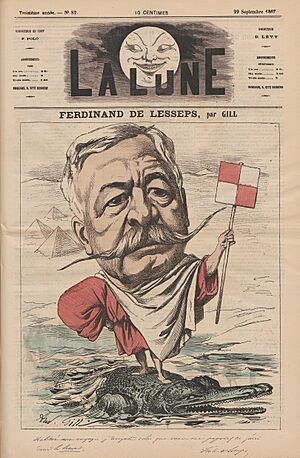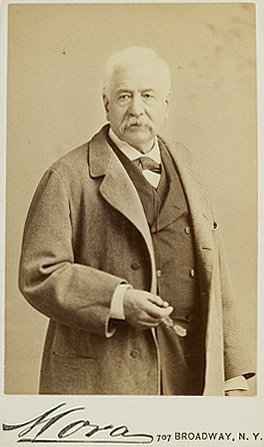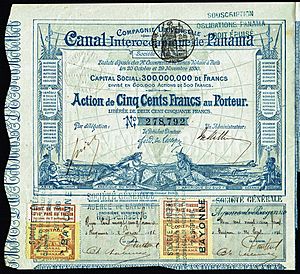Ferdinand de Lesseps facts for kids
Quick facts for kids
Ferdinand de Lesseps
|
|
|---|---|
 |
|
| Born | 19 November 1805 |
| Died | 7 December 1894 (aged 89) Guilly, French Republic
|
| Citizenship | France |
| Alma mater | Lycée Henri-IV, Paris |
| Occupation | Diplomat, entrepreneur |
| Known for | Suez Canal, Panama Canal |
|
Works
|
Recollections of forty years (1887) |
| Awards | Albert Medal (1870) |
| Signature | |
Ferdinand Marie, Comte de Lesseps (born November 19, 1805 – died December 7, 1894) was a French diplomat and businessman. He is most famous for leading the project to build the Suez Canal. This amazing waterway opened in 1869. It connected the Mediterranean Sea and the Red Sea. This made sea travel much shorter between Europe and East Asia.
Later, he tried to build another big canal, the Panama Canal, in the 1880s. This project faced huge challenges. Many workers got sick from diseases like malaria and yellow fever. There were also big financial problems. This Panama Canal project was never finished by his company. The United States later took over the project. They found ways to control the diseases and changed the canal's design. The Panama Canal was finally completed in 1914.
Contents
Early Life and Family
Ferdinand de Lesseps was born in Versailles, France, on November 19, 1805. He spent his early childhood in Italy. His father was a diplomat there. Ferdinand went to school at the College of Henry IV in Paris.
When he was 18, he started working for the army's supply department. From 1825 to 1827, he worked in Lisbon, Portugal. His uncle, Barthélemy de Lesseps, was a French diplomat there. His uncle was a famous explorer who had traveled around the world.
Diplomatic Career
In 1828, Ferdinand de Lesseps became an assistant vice-consul in Tunis. His father was the consul-general there. Ferdinand helped a man named Youssouff escape danger. Youssouff later became a brave soldier in the French army.
Working in Egypt
In 1832, Lesseps became a vice-consul in Alexandria, Egypt. While he was in quarantine, he read a book about a plan for a canal. This book sparked his interest in building a canal across the African isthmus. He became good friends with Said Pasha, the son of Egypt's ruler, Muhammad Ali Pasha. This friendship would be very important later.
Lesseps worked in Cairo and Alexandria until 1837. During this time, a serious plague spread. Lesseps worked hard to help people in both cities. In 1837, he returned to France. He married Agathe Delamalle and they had five sons.
Later Diplomatic Roles
Lesseps continued his diplomatic work in other countries. He was a consul in Rotterdam (1839) and Málaga (1840). In 1842, he became consul general in Barcelona, Spain. During a conflict there, he protected many people from different groups.
From 1848 to 1849, he was France's minister in Madrid. In 1849, he was sent to Rome to help Pope Pius IX return to the Vatican. However, political changes in France led to his recall. He left the diplomatic service after this.
In 1853, Lesseps faced personal sadness. He lost his wife and one of his sons. But in 1854, his friend Said Pasha became the new ruler of Egypt. This gave Lesseps a new chance to pursue his dream of the Suez Canal.
Building the Suez Canal
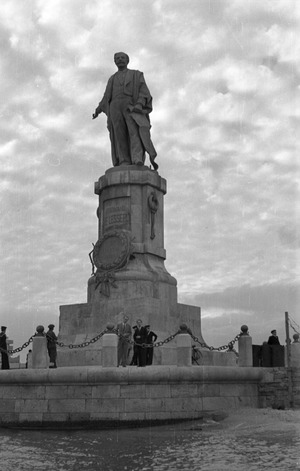
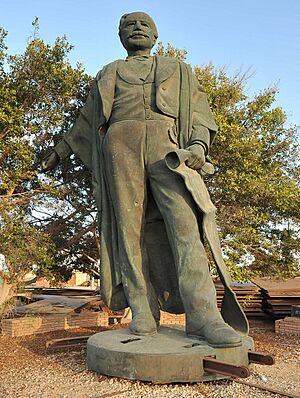
On November 7, 1854, Lesseps arrived in Alexandria. On November 30, Said Pasha signed a special agreement. This agreement allowed Lesseps to build the Suez Canal.
Two French engineers in Egypt, Linant Bey and Mougel Bey, quickly drew up a plan. Their plan was for a direct link between the Mediterranean and Red Seas. This plan was approved in 1856 by a group of engineers. Lesseps was determined to make it happen.
Overcoming Challenges
Lesseps faced many challenges. The British government, led by Lord Palmerston, was against the canal. They thought it would harm Britain's trade and power. People also worried that the canal would fill with mud and sand.
Lesseps worked hard to get support. He convinced many French people to invest in the project. They bought more than half of the shares needed. The Egyptian government bought the rest.
The Suez Canal Company was officially started in late 1858. On April 25, 1859, Lesseps himself struck the first blow at Port Said. For the next ten years, he continued to fight against British opposition. He even asked his cousin, Empress Eugenie, for help.
Finally, on November 17, 1869, the Suez Canal was officially opened. The ruler of Egypt, Ismail Pasha, was there for the grand ceremony.
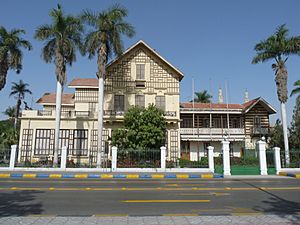
Lesseps always tried to stay out of politics. He focused on the canal's success. When Britain later bought shares in the canal, Lesseps welcomed British representatives to the company's board. This helped the canal become even more successful for everyone.
In 1873, Lesseps became interested in a railway project. It aimed to connect Europe and Asia by train to Mumbai and Beijing. He also became a member of the French Academy of Sciences. He supported other big projects, like a plan to create an inland sea in the Sahara desert.
He also helped explorers in Africa. His work helped establish the French Congo. In 1879, he was made an honorary member of the American Academy of Arts and Sciences.
For many years, a large statue of Ferdinand de Lesseps stood at the entrance of the Suez Canal.
The Panama Canal Challenge
In May 1879, a group of experts met in Paris. They voted to build a Panama Canal. They decided it should be a sea-level canal, just like the Suez Canal. Lesseps, even at 74 years old, was chosen to lead the Panama Canal Company. People called him "Le Grand Français" (The Great Frenchman).
However, building a sea-level canal in Panama was extremely difficult. The biggest problems were the terrible epidemics of malaria and yellow fever. Doctors at the time did not know how to stop these diseases. Many workers died.
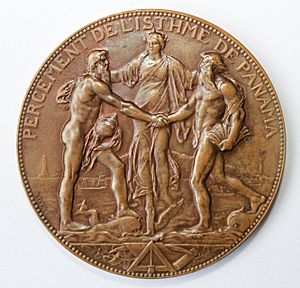
In February 1880, Lesseps traveled to the United States. He wanted to raise money for the project. He met with important people, including President Rutherford B. Hayes. He also visited many American cities to get support.
Work on the canal began in 1882. Lesseps thought it would cost 658 million francs and take eight years. But the technical challenges were immense. There were frequent landslides from the wet hills into the digging sites. The high number of deaths from disease also made it very hard.
In the end, the project ran out of money. There were also accusations of financial problems. The Panama Canal Company went bankrupt in December 1888. The project was never completed by Lesseps's company. Later, in 1904, the United States bought the company's assets. They finished the canal using a different design, with locks, and after solving the health issues.
Later Life and Legacy
In November 1869, just after the Suez Canal opened, Lesseps married his second wife, Louise-Hélène Autard de Bragard. She was much younger than him. They had twelve children together, and eleven of them lived longer than their father.
Statue of Liberty
In 1884, Lesseps was honored at a special dinner in France. It was to celebrate the completion of the Statue of Liberty. In October 1886, Lesseps traveled to the United States. He spoke at the dedication ceremony for the Statue of Liberty, with President Grover Cleveland present.
Death
Ferdinand de Lesseps died on December 7, 1894, at his home in Guilly, France. He was buried in the Père Lachaise Cemetery in Paris.
Lasting Impact
Lesseps's legacy is most strongly linked to the Suez Canal. On July 26, 1956, the Egyptian President Gamal Abdel Nasser used Lesseps's name as a secret code. This code signaled the takeover of the Suez Canal Company by Egypt. The statue of Lesseps at the canal's entrance was removed. This symbolized the end of European control over the waterway. The statue is now in a garden at the Port Fuad shipyard.
See also
 In Spanish: Ferdinand de Lesseps para niños
In Spanish: Ferdinand de Lesseps para niños
- Lesseps metro station in the Barcelona Metro
- Fort De Lesseps, a U.S. military base in Panama was named in his honor


